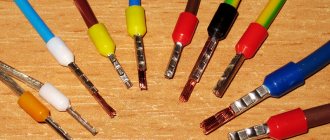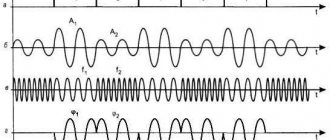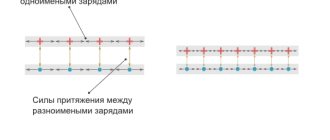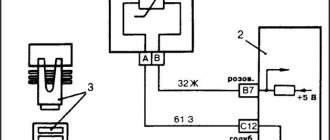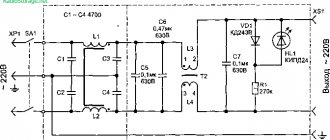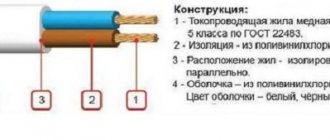In industry and consumer electronics, photoresistors are used to measure light, count the amount of something, detect obstacles, and more. Its main purpose is to convert the amount of light falling on a sensitive area into a useful electrical signal. The signal can subsequently be processed by an analog, digital, or microcontroller-based logic circuit. In this article we will tell you how a photoresistor works and how its properties change under the influence of light.
Basic concepts and device
A photoresistor is a semiconductor device whose resistance (conductivity, if convenient) varies depending on how strongly its sensitive surface is illuminated. Structurally, they are found in various designs. The most common elements of this design are as shown in the figure below. At the same time, to work under specific conditions, you can find photoresistors enclosed in a metal case with a window through which light enters the sensitive surface. Below you see its conventional graphic designation in the diagram.
Designation on diagrams
A photoresistor on a circuit diagram is designated almost the same as a standard resistor. But there is a slight difference. This is still the same rectangle, but in a circle, outside of which there is an image of two arrows at an angle of 45°. These arrows symbolically show the radiation flux incident on the element.
This designation was adopted by the international electrotechnical commission IEC (International Electrotechnical Commission).
In foreign sources you can see another symbol. The photocell is conventionally shown as a broken line. This is an outdated symbol, but it can also be found on diagrams quite often.
Samsung washing machine error codes
It is much easier to determine damage if there is a display on the control panel. In case of malfunctions, symbols are displayed on it, each of which corresponds to a specific breakdown.
| Basic error codes | Corresponding fault |
| 4C | Water does not fill or fills too slowly (the filling process takes more than 20 minutes) |
| 4С2 | Make sure that the inlet hose is connected to the cold water pipe |
| A0,B0,C0,D0,E0 | Diagnostics of the washing machine is enabled (test mode, which is used at the factory) |
| 5C, 5E, E2 | Water does not drain |
| dC | Door is open |
| O.C. | Excess water, you should spin the machine and restart it |
| LC,LC1 | Problems with the inlet hose |
| Ub | Spin does not work |
| U.C. | No power supply, low voltage, check connection |
| 3C | Engine doesn't work |
| NS | The heating temperature has been exceeded; the thermostat may be faulty |
| 1C | The water level sensor is not working correctly |
| DDC,ddC | Appears if the Add Door (for loading forgotten laundry) is opened without pressing the Start or Pause button. |
| DC3 | Add Door lock does not work correctly |
| Sd | Too much foam |
| DC1 | The main door lock did not work correctly |
| Sun | The unit cannot start the engine |
| PoF | There was a power outage during the washing process |
| Hot | During the drying process, the temperature inside the drum exceeded 700C |
| LE,LC,E9 | Spontaneous drainage of water due to a low-lying hose or a leak. |
Please note that the listed fault codes are periodically modified and new ones are added. Therefore, before starting repair work, you should check the list of errors specified in the instructions.
Sensitivity and inertia of the photoresistor
The sensitivity of a photoresistor depends on the wavelength of light. If the wavelength lies outside the operating range, then the light has no effect on the phase distribution. We can say that the photoresistor is not sensitive in this wavelength range. These radio components have lower sensitivity than phototransistors and photodiodes.
Another important characteristic of a photoresistor is called inertia; its physical meaning is that there is a certain inertia (or, more simply, a delay time) between changes in illumination and the subsequent change in resistance. It takes about 10 ms for the resistance to drop to its minimum possible value in full light, and about one second for the resistance to rise to its maximum after darkening the same component.
Sensitivity and inertia of the photoresistor.
Parallel connection
Quite often it is necessary to connect several diodes to one source. Theoretically, to power several parallel-connected LEDs, one current-limiting resistor can be used. In this case, the formulas will look like this:
R = (Uist - Un) / (n ⋅ In)
P = (n ⋅ Iн)2 ⋅ R
Where n is the number of parallel-connected LEDs.
Why can't you use one resistor for several parallel diodes?
Even in “Chinese” products, manufacturers install a separate current-limiting resistor for each LED. The fact is that in the case of a common ballast for several LEDs, the probability of failure of light-emitting diodes increases many times over.
If one of the semiconductors breaks, its current will be redistributed through the remaining LEDs. The power dissipated on them will increase and they will begin to heat up intensely. Due to overheating, the next diode will fail and the process will then take on an avalanche-like character.
Example of correct resistor connection
Principle of operation
Let's figure out how a photoresistor works?
When it is inactive it is essentially a dielectric. In order for a device to begin conducting current, an external influence must be exerted on it. Thermal or, as in our case, light.
Photons of light hitting the active layer saturate it with electrons, and now the ability to transmit electric current appears. A direct relationship arises that can be displayed on a graph.
The graph clearly shows that the more electrons are formed, the lower the electrical resistance of the semiconductor. The principle of its operation is based on this property of the photoresistor.
Moreover, the effect of electron formation can cause both the visible spectrum of radiation and the infrared. In the latter version, they are capable of creating significantly greater energy.
The susceptibility of the photoresist layer can be increased by doping it with various additives. After such treatment, photoresistance decreases, but photosensitivity in the visible light spectrum increases.
These elements are characterized by the aging process. It is expressed:
- in reducing ohmic resistance;
- photocurrent changes;
- sensitivity increases.
This process does not last long - up to several hundred hours, and then the parameters become stable.
Calculation of LED resistor (using formulas)
When calculating, two quantities are calculated:
- Resistance (value) of the resistor;
- power dissipated by it P.
The voltage sources powering the LEDs have different output voltages. In order to select a resistor for an LED, you need to know the source voltage (Uist), the operating voltage drop across the diode and its rated current. The formula for calculation is as follows:
R = (Uist - Un) / In
When we subtract the nominal voltage drop across the LED from the source voltage, we get the voltage drop across the resistor. Dividing the resulting value by the current, according to Ohm's law, we obtain the value of the current-limiting resistor. We substitute the voltage expressed in volts, the current in amperes and get the nominal value expressed in ohms.
The electrical power dissipated by the damping resistance is calculated using the following formula:
P = (In)2 ⋅ R
Based on the obtained value, the power of the ballast resistor is selected. For reliable operation of the device, it must be higher than the calculated value. Let's look at an example of a calculation.
Example of calculating a resistor for a 12 V LED
Let's calculate the resistance for an LED powered by a 12V DC voltage source.
Let's say we have at our disposal a popular super-bright SMD 2835 (2.8mm x 3.5mm) with an operating current of 150mA and a voltage drop of 3.2V. SMD 2835 has an electrical power of 0.5 watts. Let's substitute the original values into the formula.
R = (12 - 3.2) / 0.15 ≈ 60
We find that a quenching resistor with a resistance of 60 Ohms is suitable. The closest value from the standard E24 series is 62 ohms. Thus, for the LED we have chosen, we can use a ballast with a resistance of 62 Ohms.
Now let's calculate the power dissipation across the resistance.
P = (0.15)2 ⋅ 62 ≈ 1.4
Almost one and a half watts of electrical power will be dissipated at the resistance we have chosen. This means that for our purposes we can use a resistor with a maximum permissible power dissipation of 2W.
All that remains is to buy a resistor with a suitable value. If you have old boards from which parts can be desoldered, then you can select a resistor based on the color marking. Use the form below.
On a note! In the example above, the current limiting resistor dissipates almost three times as much energy as the LED. This means that taking into account the luminous efficiency of the LED, the efficiency of our design is less than 25%.
To reduce energy losses, it is better to use a source with a lower voltage. For example, you can use an AC/AC 12/5 volt DC/DC converter for power supply. Even taking into account the efficiency of the converter, the losses will be significantly less.
An example sketch of a light sensor on a photoresistor
We connected the circuit with the photoresistor to the Arduino and made sure that everything was done correctly. Now all that remains is to program the controller.
Writing a sketch for a light sensor is quite simple. We only need to remove the current voltage value from the analog pin to which the sensor is connected. This is done using the analogRead() function we all know. We can then perform some actions depending on the light level.
Let's write a sketch for a light sensor that turns on or off an LED connected according to the following circuit.
The operating algorithm is as follows:
- Determine the signal level from the analog pin.
- We compare the level with the threshold value. The maximum value will correspond to darkness, the minimum value will correspond to maximum illumination. Let's choose a threshold value equal to 300.
- If the level is less than the threshold, it is dark, you need to turn on the LED.
- Otherwise, turn off the LED.
#define PIN_LED 13 #define PIN_PHOTO_SENSOR A0 void setup() { Serial.begin(9600); pinMode(PIN_LED, OUTPUT); } void loop() { int val = analogRead(PIN_PHOTO_SENSOR); Serial.println(val); if (val < 300) { digitalWrite(PIN_LED, LOW); } else { digitalWrite(PIN_LED, HIGH); } } By covering the photoresistor (with your hands or a light-proof object), we can observe the LED turning on and off. By changing the threshold parameter in the code, we can force the light bulb to turn on/off at different lighting levels.
When installing, try to place the photoresistor and LED as far apart from each other as possible so that less light from the bright LED falls on the light sensor.
Connecting a photoresistor to Arduino
Arduino projects, a photoresistor is used as a light sensor. Receiving information from it, the board can turn relays on or off, start engines, and send messages. Naturally, we must connect the sensor correctly.
The connection diagram for the light sensor to the Arduino is quite simple. If we use a photoresistor, then in the connection diagram the sensor is implemented as a voltage divider. One arm changes depending on the illumination level, the second one supplies voltage to the analog input. In the controller chip, this voltage is converted into digital data through an ADC. Because When the resistance of the sensor decreases when light hits it, the value of the voltage falling across it will also decrease.
Depending on which arm of the divider we placed the photoresistor in, either increased or decreased voltage will be supplied to the analog input. If one leg of the photoresistor is connected to ground, then the maximum voltage value will correspond to darkness (the resistance of the photoresistor is maximum, almost all the voltage drops across it), and the minimum value will correspond to good lighting (resistance is close to zero, voltage is minimal). If we connect the photoresistor arm to the power supply, the behavior will be the opposite.
Installing the board itself should not cause any difficulties. Since the photoresistor has no polarity, it can be connected from either side; it can be soldered to the board, connected with wires using a circuit board, or used with ordinary clips (crocodile clips) for connection. The power source in the circuit is the Arduino itself. The photoresistor is connected with one leg to the ground, the other is connected to the ADC board (in our example - AO). We connect a 10 kOhm resistor to the same leg. Naturally, you can connect a photoresistor not only to analog pin A0, but also to any other.
A few words about the additional 10 K resistor. It has two functions in our circuit: limiting the current in the circuit and generating the required voltage in the circuit with a divider. Current limitation is necessary in a situation where a fully illuminated photoresistor sharply reduces its resistance. And voltage generation is for predictable values on the analog port. In fact, for normal operation with our photoresistors, a resistance of 1K is enough.
By changing the resistor value we can “shift” the sensitivity level to the “dark” and “light” sides. So, 10 K will give a quick switching of the onset of light. In the case of 1K, the light sensor will more accurately detect high light levels.
If you use a ready-made light sensor module, the connection will be even simpler. We connect the output of the VCC module to the 5V connector on the board, GND to ground. We connect the remaining pins to the Arduino connectors.
If the board has a digital output, then we send it to digital pins. If it’s analog, then go to analog. In the first case, we will receive a trigger signal - the illumination level has been exceeded (the trigger threshold can be adjusted using an adjustment resistor). From the analog pins we will be able to obtain a voltage value proportional to the actual illumination level.
The principle of operation of photoresistors
Using photoresistors, the presence or absence of light is determined, and the intensity of the light flux can be checked and measured. In complete darkness, their resistance increases significantly and can reach 1 MOhm. Under the influence of light, the resistance, on the contrary, begins to drop sharply, and its value will completely depend on the intensity of the light.
Depending on the materials used for the manufacture of photoresistors, these devices are divided into two groups, the main features of which are internal and external photoeffects.
Elements with internal photoelectric effect are made from unalloyed materials - germanium or silicon. Their operating principle is quite simple. When photons hit the surface of the device, they set electrons in motion. As a result, they begin to move from the valence region to the conduction band. Further, free electrons appear in large quantities in the material, helping to improve conductivity and a corresponding decrease in resistance. This explains in general terms how a photoresistor works.
Achieving an external photoelectric effect becomes possible due to the materials from which the photoresistor is made. To impart the desired properties, special impurities are added to them, known as alloying additives. They change the parameters in the desired direction and contribute to the creation of a new energy band, saturated with electrons, on top of the existing valence region. Such electrons require much less energy to move into the conduction band. The result of this is increased sensitivity of photoresistors to different wavelengths of light.
Checking the resistor with a multimeter
A black probe is inserted into the COM connector, and a red one into the VΩ connector. VΩ is a measurement of voltage and resistance.
One denotes two situations. If the resistor has a resistance higher than the selected limit, the multimeter will show an off-scale value. A unit also means that the device does not see the radio component or there is poor contact between the probes and the part.
A dot on the screen shows the measurement limit. Here the limit selected is 20 kOhm.
The multimeter shows 2.7 kOhm. When taking measurements, you must not touch two metal bases of the probes at the same time. Your body may shunt the part being measured and the parting reading will be false.
The same thing applies to resistors whose resistance ratings are higher than that of the device being measured. You can also check it using a diode test. If the resistor is working properly, the diode continuity test will not squeak, it will show a voltage drop. But there is a problem here too.
The principle of operation of a photoresistor
The operating principle of a photoresistor is based on a phenomenon called photoconductivity (photoresistive effect) , which refers to the internal photoelectric effect, that is, a change in the electrical conductivity of a substance when it is exposed to electromagnetic radiation.
The basis of any photoresistor is a semiconductor. Under the influence of electromagnetic radiation (visible light or infrared), the number of current carriers in the semiconductor substance increases. Therefore, as a result of illumination of a semiconductor, its resistance decreases, and when darkened, on the contrary, it increases.
You can clearly see the change in the resistance of the photoresistor using a multimeter.
We connect the leads of the photoresistor to the probes of the multimeter turned on in ohmmeter mode.
The light resistance of photoresistors of the GM series (GM35**, GM45**, GM55**, GM75**, GM125**, GM205**, GM255**) lies in the range of 5...200 kOhm (depending on the specific product) under illumination at 10 lux. Therefore, the measurement limit can be set to several kilo-ohms (2k, 20k or 200k).
The photo shows the resistance of the imported photoresistor GM55** (presumably GM5516, also known as GL5516) in the illuminated state. As you can see, it is 1.1 kiloohms.
If the photoresistor is covered with a dark cloth or simply covered with the palm of your hand, its resistance will increase sharply. At the same time, in order to see the measurement result, most likely you will have to switch the measurement limit on the multimeter towards larger limits, usually megaohms.
When darkening, the resistance of our photoresistor increased to 121 kiloohms.
It is worth understanding that photoresistors are made from semiconductors with one type of conductivity, so they do not have any pn junctions in their structure. Due to this, the photoresistor is non-polar and can be included in the circuit without observing it, unlike, for example, a photodiode or phototransistor.
Term
A photoresistor is essentially a semiconductor device that, under the influence of light, is capable of changing its conductivity or resistance.
They are distinguished by the absence of a pn junction, which is freely used in solar photographic plates.
And since there is no pn junction, then such an element has the property of passing current regardless of its direction. This distinctive feature makes it possible to use them in AC or DC electrical circuits.
Kinds
Despite the variety of photo sensors, they can be divided into only two types:
- Photoresistors with internal photoeffect;
- Sensors with external photoeffect.
They differ only in production technology, or more precisely, in the composition of the photoresist layer. The first are photoresistors, in which the semiconductor is made from pure chemical elements, without impurities. They are insensitive to visible light, but respond well to heat rays (infrared light).
Photoresistors with external effect contain impurities that dope the main composition of the semiconductor substance. The sensitivity spectrum of these sensors is much wider and moves into the visible spectrum and even into the UV radiation zone.
According to the principle of operation, these two types of photoresistors do not differ. Their internal resistance decreases nonlinearly with increasing intensity of the light flux in the sensitivity zone.
Advantages and disadvantages
These elements have a significant drawback - the cutoff frequency. It sets the maximum frequency of the sinusoidal signal that regulates the luminous flux.
As a result, the sensitivity of the device is significantly reduced. Accordingly, the performance of devices also decreases, where it takes about ten microseconds to respond - 10^(−5) s.
Some inertia of sensors based on photoresistors also appears. There is a delay in the signal, and this negatively affects the performance of the devices.
But there are also positive aspects.
At a low sensitivity threshold, the photoresistor is inexpensive and its connection is justified by high reliability. Often, it is even useful that the photocell is triggered not instantly, but incrementally, gradually. This feature makes it possible to use these parts in analog-type devices - various sensors and light meters.
Typical photo relay malfunctions
Failures in the use of photo relays are most often caused by their incorrect selection and/or operation. The most common failures are exceeding the resource, but a number of other reasons can be listed:
- Exceeding the permissible current and/or voltage.
- Failures related to cycle time (especially when the relay switches at very low signal levels or when the relay does not operate very often, causing the contacts to oxidize).
- Contamination of the working surface of photo sensors (especially typical for photo relays that serve industrial equipment).
- Poor ventilation of relay panels, which causes overheating of MOSFET transistors.
With proper routine maintenance, all of these problems can be prevented. The service life of the relay and its rated power are always indicated by the manufacturer. These parameters are determined for photorelay operation under low level switching conditions and correspond to the minimum number of operations that can be expected without mechanical failure due to contact wear.
It is much more informative when the developer indicates in the operating instructions the service life of the relay under conditions of hot load switching, when the current and voltage values are maximum (at the rated power of the device). In these cases, the relay fails due to contamination of the contact material, when current and voltage have to be increased to operate: this is accompanied by a sharp increase in resistance during the passage of the control signal. Therefore, light-receiving surfaces should be cleaned as often as possible, using chemically neutral cleaners for these purposes.
When used intensively, photorelay sensors never operate longer than indicated in their technical specifications. Even in low-signal applications, faults in the testing devices can cause device failures. As a result, inrush currents caused by capacitive loads, hot switching and voltage surges accelerate their aging.
How to determine the health of SMD resistors
SMD resistors are surface-mount components, the main difference of which is the absence of holes in the board. The components are installed on the current-carrying contacts of the printed circuit board. The advantage of SMD components is their small dimensions , which makes it possible to reduce the weight and size of printed circuit boards.
Testing SMD resistors with a multimeter becomes more difficult due to the small size of the components and their labels. The resistance value on SMD components is indicated as a code in special tables, for example, the designation 100 or 10R0 corresponds to 10 Ohms, 102 indicates 1 kOhm. Four-digit designations may occur, for example 7920, where 792 is the value and 0 is the multiplier, which corresponds to 792 ohms.
Application area
In the modern world, the scope of application of these radio components has been significantly expanded.
The use of various photoresistors operating in the visible spectrum is quite extensive. It can be:
- Automatic light switch systems.
- Counting devices.
- Web or paper break sensors.
- Intrusion sensors.
- In devices equipped with exposure meters. For example, such elements could be used in standard point-and-shoot cameras.
In themselves, they are only an element of complex photodetector devices, which, in addition to the photodetector, may include:
- integrated amplifier;
- a microcircuit responsible for automatic lighting adjustment;
- power circuit diagrams, supplemented by a cooling system based on Peltier elements.
All this variety of elements for photodetectors is contained in a small sealed housing.
If these devices operate in the IR range, their scope is slightly different. They are used as part of complex devices such as:
- flame detection sensors;
- non-contact temperature measurement systems;
- humidity level monitoring systems;
- used to detect carbon dioxide;
- in infrared gas analyzers;
- used in paper tape break sensors in printing houses or in the paper industry;
- in industrial electronics, connecting a photoresistor can be used to automatically count products that move along a conveyor belt.
Accordingly, based on the fact that such a resistor will be controlled, its parameters are calculated.
For an example of how this element is used in practice, let's look at the photo relay circuit that controls street lighting.
Automation of street lighting
Automatic devices that turn on street lighting are able to detect the presence/absence of sunlight.
Here is a typical implementation diagram for connecting a photoresistor to automatically activate a night lighting device.
In general terms, the principle of operation of the circuit.
With the onset of twilight and at night, the resistance of the LDR increases, which causes a decrease in the voltage across the variable resistor R2. Transistor VT1 is closed, and VT2 opens, thus supplying voltage to the relay that turns on the lamp.
This is a completely working photo relay circuit, but its main drawback is the lack of hysteresis. This causes the relay to briefly buzz during twilight hours when there are slight changes in illumination.
This electronic part helps monitor the ambient light level.
Sensors for other conditions
In the printing industry, designs using a special photoresistor monitor the breakage of a paper roll. They can also be used to count paper sheets on a conveyor belt.
Connecting a photoresistor to Arduino
Light sensors that can use photoresistors can be implemented with your own hands based on Arduino boards.
Such schemes are quite simple, there is no question of “where to get them”, since they are available in online stores, and their price does not scare away customers.
A homemade module makes it possible to control the light level and react to its changes.
Having such an Arduino board in hand, it is easy to implement projects such as:
- light sensor;
- to turn on/off the relay;
- starts engines and so on.
Here is a typical example of using a light detector based on an Arduino board.
Types of photoresistors
Photoresistors are divided into two types depending on the material from which they are made:
- Internal photoelectric effect
- External photoeffect
Photoresistor with internal photoelectric effect
Proprietary photoresistors are made from pure semiconductor materials such as silicon or germanium. The outer shell of any atom can contain up to eight valence electrons. However, in silicon or germanium, each atom consists of only four valence electrons. These four valence electrons of each atom form four covalent bonds with the neighboring four atoms to completely fill the outer shell. As a result, not a single electron remains free.
When we apply light energy to an intrinsic effect photoresistor, only a small number of valence electrons receive enough energy and are released from the parent atom. Consequently, a small number of charge carriers are generated. As a result, only a small electrical current flows through the internal photoresistor.
Internal photoresistors are less sensitive to light, so they are not reliable for practical use.
Photoresistor with external photoeffect
Photoresistors with external photoelectric effect are made of external semiconductor materials. Consider an example of an external photoresistor made from a combination of silicon atoms and a phosphorus impurity.
Each silicon atom consists of four valence electrons, and each phosphorus atom consists of five valence electrons.
The four valence electrons of the phosphorus atom form four covalent bonds with the neighboring four silicon atoms. However, the fifth valence electron of a phosphorus atom cannot form a covalent bond with a silicon atom because a silicon atom has only four valence electrons. Consequently, the fifth valence electron of each phosphorus atom is released from the atom. Thus, each phosphorus atom generates a free electron.
The free electron that is generated collides with the valence electrons of other atoms and makes them free. Likewise, one free electron generates several free electrons. Therefore, adding a small amount of impurity (phosphorus) atoms generates millions of free electrons.
External photoresistors already contain a large number of charge carriers. Therefore, providing a small amount of light energy generates even more charge carriers. Thus, the electric current increases rapidly.
An increase in electrical current means a decrease in resistance. The resistance of the external photoresistor decreases rapidly with small increases in applied light energy. External photoresistors are reliable for practical applications.
Universal color chart
There is a universal color table that allows you to quickly calculate the values of each resistor if necessary.
When creating such a table, the following fields are selected:
- The color of the ring or dot applied. In this case, both the name and an example are given.
- Depending on the value of the color, it is possible to convert the color coding into a numerical value. This is necessary when creating a diagram for symbolizing denominations.
- The multiplier allows for a mathematical calculation of what resistance the design in question has.
- Also, for almost every color there is a field that indicates the maximum deviation from the nominal value.
It is worth remembering that each color can indicate a number in the marking, a multiplier value, or a maximum deviation.
Examples
Example 1:
Let us consider the use of such a table using the following example: brown, black, red, silver. We read the rings from left to right, the resulting value is always encoded in Ohms.
According to the data from the table, we carry out the following decoding:
- The brown color in the first position represents both the digit and the multiplier. In this case, the number will be “1” and the multiplier “10”. It is worth noting that the following colors cannot be used in the first position: black, gold or white.
- The second color means the number of the second digit. Black means "0" and is not used in calculations. Having such data, we can conclude that the resistor has the alphanumeric marking 1K0.
- The third color determines the multiplier. In our case, it is red, the multiplier of this color is “100”.
- The last color means the maximum tolerance for deviation, and the silver color corresponds to 10%.
Using the table, we can say that the resistor in question is marked 1K0 and has a resistance value of 1000 Ohms (10*100) or 1 kOhm, as well as a tolerance of 10%.
Example 2:
Another more complex example is the calculation of the nominal values of the following resistor: red, blue, purple, green, brown, brown. This marking consists of 6 rings.
When decrypting, we note the following:
1 ring, red – number “2”.
2nd ring, blue – number “6”.
3rd ring, purple – number “7”.
We select all numbers from the table. When they are combined, we get the number “267”.
4 ring is green
In this case, we pay attention not to the numerical value, but to the multiplier. Green color corresponds to a multiplier of 105. We carry out the calculation: 267 * 105 = 2.67 MOhm.
5 ring is brown and corresponds to a maximum deviation of 1% in both directions.
Line 6 is brown, which corresponds to a temperature coefficient of 100 ppm/°C.
From the above example, we can say that deciphering the markings is not difficult, and the number of rings has virtually no effect on how complex the calculations will be. In this case, the resistor has a resistance of 2.67 MΩ with a deviation in both directions of 1% at a temperature coefficient of 100 ppm/°C.
The procedure can be simplified by using special calculators. However, not many people do the 6 ring calculation, which is worth considering.
The nominal series of resistors can be called the result of standardization of nominal values. Fixed resistors have 6 similar rows. Also, one row for variable denominations and a special row E3 have been introduced.
Using the example given denomination, let's decipher it:
- The letter “E” means that marking is carried out according to a series of denominations. This beech is always included in the designation.
- The numbers after the letter indicate the number of nominal resistance values in each decimal interval.
There are special tables displaying nominal series.
To identify standard series, GOST 2825-67 was adopted. At the same time, we can highlight several of the most popular standard series:
- Row E6 has a deviation in both directions of 20%.
- Row E 12 has a permissible deviation of 10%.
- The E24 series has a maximum permissible deviation in both directions of 5%.
The subsequent rows E48 and E96, E192 have a deviation rate of 2%, 1%, 0.5%, respectively.


